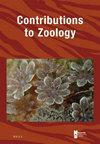Morphological and genetic diversification of pygmy and marbled newts, with the description of a new species from the wider Lisbon Peninsula (Triturus, Salamandridae)
IF 2.1
2区 生物学
Q1 ZOOLOGY
引用次数: 0
Abstract
Iberian populations of large-bodied newts, with Triturus marmoratus in the north and T. pygmaeus in the south of the peninsula, were studied for external morphology, mitochondrial dna and for a panel of single nucleotide polymorphisms. This confirmed the species’ low level of interspecific hybridization and their parapatric, mosaic-like mutual range border across the peninsula. The genetic data also revealed substantial variation within T. pygmaeus, with narrow (0.43–35.2 km) clinal transitions in the very centre of Portugal. Similar clines were observed for body size and colouration pattern. Pygmy newts in the west of Portugal are larger, with a more striped (less reticulated) green dorso-lateral colouration pattern than those in the east and south of the country. The western group of populations is described as a new species, Triturus rudolfi sp. nov., on account of a long, ca. 2.5 Ma, independent evolutionary history and limited hybridization with its sister-species T. pygmaeus, suggesting selection against hybrid offspring. The range of the newly described species may be restricted to the wider Lisbon Peninsula, stretching northwards along the Atlantic coast to the river Vouga estuary. Inland, the range border may be set by the lower Tejo River, or by the currently wide area of agricultural land at either side of that river, that may accommodate a residual hybrid zone. The close contact between both pygmy newt species is effectively limited to a ca. 20 × 40 km area directly north of the town Entroncamento, where T. rudolfi sp. nov. is sandwiched in between T. marmoratus and the river Tejo.侏儒蝾螈和大理石纹蝾螈的形态和遗传多样性,并描述了大里斯本半岛的一个新物种(Triturus,Salamandridae)
对伊比利亚半岛的大体蝾螈种群进行了外部形态、线粒体 DNA 和单核苷酸多态性研究。研究结果证实,这些物种的种间杂交程度很低,而且它们在半岛上的分布区边界呈马赛克状。遗传数据还显示,T. pygmaeus 的内部存在大量变异,在葡萄牙的最中心有狭窄的(0.43-35.2 千米)类群过渡。在体型和颜色模式方面也发现了类似的支系。与葡萄牙东部和南部的侏儒蝾螈相比,葡萄牙西部的侏儒蝾螈体型更大,背侧的绿色色斑条纹更多(网纹较少)。西部种群被描述为一个新物种 Triturus rudolfi sp.nov.,其独立进化历史悠久(约 2.5 Ma),与其姊妹种 T. pygmaeus 的杂交有限,这表明其杂交后代受到了选择的抑制。新描述物种的分布范围可能仅限于里斯本半岛,沿大西洋海岸向北延伸至沃加河河口。在内陆,该物种的分布区边界可能是特茹河下游,或者是特茹河两侧目前广阔的农田,那里可能是残留的杂交区。两种侏儒蝾螈之间的密切接触实际上仅限于 Entroncamento 镇正北方约 20 × 40 千米的区域,在该区域,T. rudolfi sp.
本文章由计算机程序翻译,如有差异,请以英文原文为准。
求助全文
约1分钟内获得全文
求助全文
来源期刊

Contributions to Zoology
生物-动物学
CiteScore
4.00
自引率
4.50%
发文量
16
审稿时长
>12 weeks
期刊介绍:
Contributions to Zoology solicits high-quality papers in all systematics-related branches of comparative zoology (including paleozoology). Preference will be given to manuscripts dealing with conceptual issues and to integrative papers (e.g., ecology and biodiversity, morphology and phylogeny and character state evolution, phylogeny and historical biogeography, systematics and bioinformatics, bioinformatics and biodiversity, habitat disturbance and biogeography, etc.). Reviews and alpha-taxonomic contributions are considered for publication, but acceptance will depend on their high quality and exceptional nature.
 求助内容:
求助内容: 应助结果提醒方式:
应助结果提醒方式:


